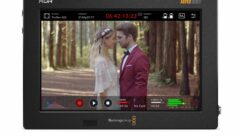The Promise Of The All-Digital Video Chain
The explosion of consumer interest in plasma displays, HDTV, digital cable television, and Internet video is indisputable evidence that the proverbial digital video train has left the station. And Bruce Kaufmann, president of Professional Products, a Gaithersburg, MD-based AV design-build firm, is already onboard.
Audio as a DSP modelDefining audio quality
The explosion of consumer interest in plasma displays, HDTV, digital cable television, and Internet video is indisputable evidence that the proverbial digital video train has left the station. And Bruce Kaufmann, president of Professional Products, a Gaithersburg, MD-based AV design-build firm, is already onboard.
An early adopter of digital video technology, his systems integration firm is working toward all-digital video solutions on many of its installations, including the Georgetown University Medical Center in Washington, D.C. Its clinical skills system, featured on the front cover, is an excellent example of digital video acquisition and distribution over IP.
The Georgetown clinical skills center consists of 10 examination rooms that medical students use to practice and develop their clinical examination skills. Each of these rooms has two ceiling-mounted cameras and two ceiling-mounted microphones. All of the exam room video and audio feeds are sent to the control room (shown in the photo) where they’re encoded into individual MPEG-4 video streams available on a LAN. Authorized users can decode and view these streams in real time on their computers. Professors and administrators are able to unobtrusively view and hear the students as they conduct examinations. Authorized observers can select any of the exam rooms and control the pan/tilt/zoom cameras from anywhere on the clinical skills LAN. Video from the exam rooms is distributed to the classrooms via IP.
But while early adopters like Kaufmann have clearly jumped on the digital bandwagon as entry prices have reached a palatable level, the pro AV industry and much of its commercial customer base, by comparison, has been a little more leery. In contrast, many are choosing to wait for the next train that might take them to the “all-digital” promised land more quickly, comfortably, and economically. While it’s true some systems integrators are successfully moving more clients into state-of-the-art content creation and display devices capable of producing and handling digitally created content, the reality is that both camps still have one foot planted in the more familiar world of analog-based content creation, distribution, and display.
“I think there’s a lot of interest in moving to all-digital audio/video systems for video, but there’s still some resistance,” says Hagai Gefen, president of Gefen, a Woodland Hills, CA-based provider of HDTV integration, conversion, extension, and distribution solutions. “I’ve been a little surprised at how slow the process has been, but part of the problem is that many large pro AV customers have invested in custom analog technologies that they find difficult to justify throwing away.”
But one of the overarching reasons for the slow pace of adoption of pure digital video capabilities is the complexity of an all-digital video solution in the pro AV space, unlike in consumer applications. Sheer physical distances between video source and display, combined with the need to distribute content to multiple and different types of display devices has complicated the process of conversion to an all-digital video chain that would sidestep many of the challenges inherent in two-way digital/analog conversion processes that can diminish distribution efficiency and image quality.
At the same time, analog has its drawbacks. Distance is an enemy when it comes to the quality of the analog picture that reaches the display device, raising a barrier to effective transmission of analog video signals over distances common in pro AV applications. And, of course, analog can’t compete with the resolution and quality of the higher-definition digital image that’s quickly becoming the gold standard in video.
“Right now if you have a large AV system, and you need to mix and match analog and digital sources and displays at different resolutions, you may just choose analog because it’s easier to put together,” Gefen says. “But once you discover how to mix and match digital displays and sources that adhere to the HDTV resolution formats, you’ll realize the components have less maintenance, better quality, and less need for tweaking and aligning.
Digital technology has certainly done just that in the pro audio sphere. Digital signal processing (DSP) gear in the form of popular distribution matrix products like the Peavey MediaMatrix, Biamp Audia, and Symetrix Audio’s SymNet (to name just a few) has vastly simplified the job of retrieving, processing, and distributing audio to amps and loudspeakers — all without missing a sonic quality beat. Via a computer interface, audio signals can be handled completely in the digital domain in a single box, bypassing the bulky analog components and connections commonly used to accomplish the task.
Given the growing popularity of DSP in the audio universe, coupled with the challenges that video distribution is facing in the digital realm, one question naturally arises. Is a configurable DSP solution in the cards for video? Or more specifically, can video, with its bandwidth requirements, multiple display formats and resolutions, and multiple types —from component to high-definition to computer-generated — be similarly massaged and managed in an all-digital environment?
Pierre Berthet, chief technical officer with Analog Way, a Paris-based analog image converter manufacturer, says he can envision a configurable DSP box solution, but the picture is still blurry.
“Yes, there’s something like that in the industry’s future, but it will take quite a long time to ingest these ‘ultra-compact’ video technologies,” he says. “Even in the commercial pro audio field, the concept of all-in-one devices started slowly with products like MediaMatrix and then BSS’ Audio Soundweb and Atlas Sound’s Varizone. And like many new ideas, it could take some time to spread.”
One of the major challenges relates to video’s bandwidth requirements combined with the rate at which the core processing capability of CPUs advances, Berthet says. Even with that capability roughly doubling every 18 months (according to so-called “Moore’s Law”), Berthet says it could take 13 years for processing power to reach the speed needed to handle all of the processing of uncompressed stream SDI video. It could take slightly longer for processing power to reach speeds necessary to similarly handle higher bandwidth HD-SDI and computer UXGA.
“It gives an idea of the complexity of the task, even if we take into account the compression of algorithms that could make it happen slightly sooner,” he adds.
If and when such a solution arrives, Berthet says its evolution will be similar to that of the single DSP solution for audio. “The processing core and the remote/network areas will be in advance of the installed digital-link between the devices,” he says. “As for the input/output, it will progress from analog to digital, and in the pro AV world the progression will likely be core processing first, followed by control hardware, networking software, and, finally, the digital serial link.”
While it’s tempting to speculate about more complete DSP solutions for video, some experts suggest taking a step back. Although DSP may do wonders for managing the distribution of audio, they remind us that audio is not video. Aside from the higher bandwidth and compression demands that video has by comparison, there may not be a real-world need for processing video as carefully as audio.
Rich Mavrogeanes, founder and president of VBrick Systems, a Wallingford, CT-based manufacturer of devices that make digital video networking possible, says end-users are much more demanding with audio than they are with video. Venue differences mandate the exact fine-tuning of audio that analog devices, and the DSP functions that mimic them, provide. The same variables simply aren’t there for video.
“The human ear is much more sensitive to disturbances than is the human eye,” he says. “Audio has more stringent requirements than video in terms of how it’s perceived at the end-user level.”
But Kaufmann says demand for the higher quality video that digital solutions can provide is growing among the commercial clients his company serves. Digital video’s slow but steady emergence in the consumer space is helping to set a standard for image quality commercial users will feel compelled to conform to.
Public spaces in which digital signage is increasingly more visible is perhaps the clearest example of the need for high-quality video, Kaufmann says. “I believe the public is tuning into digital video because they’re bombarded every day with digital content — whether it’s video-on-demand via satellite, using home DVD players, watching streaming video, or editing photos on their home computers,” he says. “It’s easier to get, and you can see it more places than you used to be able to. So as we advance in this area, digital video distribution may ultimately make more of an impact than digital audio.”
The Promise Of The All-Digital Video Chain
The explosion of consumer interest in plasma displays, HDTV, digital cable television, and Internet video is indisputable evidence that the proverbial digital video train has left the station. And Bruce Kaufmann, president of Professional Products, a Gaithersburg, MD-based AV design-build firm, is already onboard.
The conversion challengeDigital’s role in distribution
Still, some clients are rooted in a mindset that puts video quality lower on the list of priorities in managing video assets, says the firm’s Director of Technology Jim Hatcher. “The bigger challenge has simply been how to manage video over a network, and for some customers, while quality is important, it’s not the primary concern; that’s been more along the lines of how to get video over IP at 30 frames a second in simply usable form,” Hatcher says. “But quality will improve as compression algorithms are further defined and refined.”
That broadening of the quality definition is key to understanding how customers in the pro AV space will evaluate digital video solutions, says James Dias, vice president of marketing for Sonic Foundry, a Madison, WI-based provider of rich media solutions. Though they’re moving slowly to adopt digital solutions, partly because of a heavy standing investment in analog technology, Dias says clients increasingly understand the ultimate value they’ll bring.
“For non-entertainment applications, video plays a very different role than most people perceive,” Dias says. “Infusing video with other data and visual elements, synchronizing them, providing interactivity, and giving a completely new, richer media experience in the process is becoming more important in business and education applications. So our focus is on looking at how video is actually used and working toward providing richer content, not just video with more pixels and better color.”
If and when a configurable DSP solution arrives for video, the task of routing a variety of video content to different display devices, from plasma and HDTV sets to projectors and desktop computers — all with different native resolutions — will be an important function to incorporate. But that challenge is being addressed now via the incorporation of various interface technologies into source and display components.
Unveiled in 1999, digital video interface (DVI) is rapidly becoming the digital interface of choice. Its most basic form, DVI-D, eliminates the analog conversion process that’s needed to get visual data from a video card-equipped source device to a display such as an LCD or CRT. Utilizing a DVI port on an output device to transmit video produces an improved connection and a higher-quality image.
Another emerging interface is high-definition multimedia interface (HDMI). It’s designed to transmit uncompressed digital video up to 500 meters to display devices such as HDTV displays and digital projectors, rendering a high-quality image. In addition, it incorporates high-definition content protection (HDCP), a security feature that addresses piracy issues of concern to original content creators.
Dave Barnes, president of TV One, an Erlanger, KY-based manufacturer of video conversion products that’s especially active in the broadcast space, where adoption of digital video processing has been more complete, says the advent of interfaces like SDI and HDMI is an important milestone along the path to the pro AV industry’s adoption of digital video processing. That path is now obstructed, in part, by a lack of video signal standards.
“Unlike the broadcast industry, which has become standardized on a couple of formats, the pro AV market is at the mercy of display manufacturers,” Barnes says. “In pro AV, it’s become much more complex because the destination for a digital signal is a display unit, whereas for the broadcast market the ultimate destination is a transmitter that only accepts a particular standard. As long as display manufacturers continue making products that accept a variety of different standards, it will be difficult to make a lot of progress.”
In recognition of the growing need for a “single-box” solution to video processing and routing, Barnes’ company has been developing products that come close to the “all-purpose” ideal. Though not a true DSP solution, TV One’s C2-770 universal video scaler, is described as coming nearer to the ideal of “anything in-anything out” than any other conversion product on the market, according to company marketing materials. The nine-input, four-output unit combines features like scaling, up and downconversion, seamless switching, standards conversion, picture-in-picture, and frame synchronization.
One of the promises of the digital video chain is the ability to more efficiently distribute a variety of content to a large number of users using everything from Cat5 to fiber to IP. The latter is the focus of VBrick Systems, the Connecticut company that markets a VBrick MPEG video appliance that allows video content to be streamed over an Ethernet connection.
A recent application gave New York’s Beacon City School District an alternative to its aging analog video distribution system. With VBrick’s Ethernet TV system, the district, headquartered in Beacon, NY, is now able to store video digitally on a server, retrieve it, and then stream it to computer desktops or networked television sets.
Using a portable VBrick media appliance that interfaces between a video camera and a connection on the existing campus data network, events or student productions can be readily broadcast in real time. The video feed is compressed into MPEG-2 format IP video and sent across the network. “This implementation represents the cutting edge of IP video for use in large institutions,” says Michael Baker, vice president of business development for VBrick. “VBrick’s EtherneTV solution takes advantage of the existing high-bandwidth networks that are ubiquitous on educational campuses and yields a cost-effective way to quickly implement high-quality video broadcasts at a fraction of the cost of traditional cable.”
The Beacon project is the first of what the systems integration company that installed the VBrick solution envisions as a possible flood of interest in similar video-over-IP applications. Rich Horowitz, founder and chief operating officer of TekConnect, a Cherry Hill, NJ-based educational technology and consulting firm, says as school districts build out data networks, interest in using it for video, in addition to voice, will grow.
“Video over IP is a natural progression from voice over IP, and with the help of the VBrick EtherneTV solution school districts can distribute digital-quality video around LANs or WANs with very little quality degradation,” Horowitz says. “Video can be stored in digital quality and rebroadcast at will and can be seen at the same quality and speed as if it were being seen live.”
Another similar digital-based video distribution product unveiled last year is the Soloist 3 Digital Media Server from Nashville, TN-based Adtec Digital. Also billed as a digital media appliance, the product combines the functions of a digital video recorder, player, switcher, and server. It provides real-time MPEG-1 and 2 encoding from analog or serial digital sources as well as real-time transcoding of DV formats from nonlinear editors through IEEE-1394.
“The box is designed to create MPEG-2 compressed bit streams from composite video and SDI for use in stored and forward applications,” says Kevin Ancelin, Adtec’s president. “It allows for scheduled playback over local area network infrastructures of analog and uncompressed digital video.”
For all of its potential advantages, video processing and distribution using digital components still faces hurdles in the pro AV arena. The technology is still in its early developmental stages — something systems integrators should bear in mind as they look to develop effective client solutions, says Kaufmann, maintaining that analog equipment and processing still has a place.
“We preach to many of our customers that just because you may be distributing content via the Internet or moving to high-compression formats doesn’t mean you can bypass the content creation side,” he says. “You have to start with good quality before it’s compressed, or you end up with images that can look soft and blocky. To get good quality at the back end, you need good quality at the front end.”
Tom Zind is a freelance writer and researcher based in Prairie Village, KS. He has written for a variety of business-to-business publications and can be reached at [email protected].










